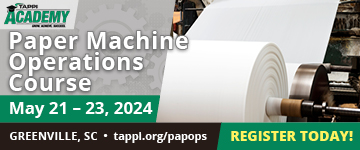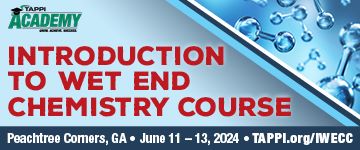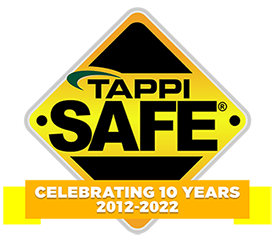 Search
Search
Use the search bar or filters below to find any TAPPI product or publication.
Filters
Content Type
Publications
Level of Knowledge
Collections
Magazine articles

Using climate change policies for u.s. pulp and paper industry efficiency, TAPPI JOURNAL, July 2000, Vol. 83(7)
Using climate change policies for u.s. pulp and paper industry efficiency, TAPPI JOURNAL, July 2000, Vol. 83(7)
Magazine articles

Chromizing for near-drum corrosion protection, TAPPI JOURNAL, September 1999, Vol. 82(9)
Chromizing for near-drum corrosion protection, TAPPI JOURNAL, September 1999, Vol. 82(9)
Magazine articles

Diverse program offered at annual coating and graphic arts division conference, TAPPI JOURNAL, August 1993, Vol. 76(8)
Diverse program offered at annual coating and graphic arts division conference, TAPPI JOURNAL, August 1993, Vol. 76(8)
Magazine articles

English as a first and second language - part 6: avoiding grammar traps, TAPPI JOURNAL, September 1998, Vol. 81(9)
English as a first and second language - part 6: avoiding grammar traps, TAPPI JOURNAL, September 1998, Vol. 81(9)
Magazine articles

ECF results please gruvon mill, TAPPI JOURNAL, January 1995, Vol. 78(1)
ECF results please gruvon mill, TAPPI JOURNAL, January 1995, Vol. 78(1)
Magazine articles

Annual tappi papermakers conference held in nashville, TAPPI JOURNAL, August 1992, Vol. 75(8)
Annual tappi papermakers conference held in nashville, TAPPI JOURNAL, August 1992, Vol. 75(8)
Journal articles

Magazine articles

Progress in foam forming technology, TAPPI JOURNAL August 2019
ABSTRACT: This paper summarizes recent developments in foam forming that were mainly carried out in pilot scale. In addition to improving the efficiency of existing processes and allowing better uniformity in material, a wide variety of raw materials can be utilized in foam forming. The focus of this paper is thin webs—papers, boards and foam-laid nonwovens, along with the pilot scale results obtained at VTT in Finland. For paper and board grades, the most direct advantage of foam forming is the potential to produce very uniform webs from longer and coarser fibers and obtain material savings through that. Another main point is increased solids content after a wet press, which may lead to significant energy savings in thermal drying. Finally, the potential to introduce “difficult” raw materials like long synthetic or manmade fibers into a papermaking process enables the manufacturing of novel products in an existing production line. This paper also briefly discusses other interesting foam-based applications, including insulation and absorbing materials, foam-laid nonwovens, and materials for replacing plastics.
Magazine articles

The practical influence of heterogeneity on tensile accelerated creep in paper, TAPPI JOURNAL, March 2001, Vol. 84(3)
The practical influence of heterogeneity on tensile accelerated creep in paper, TAPPI JOURNAL, March 2001, Vol. 84(3)
Magazine articles

Energy: recovering capital and cutting costs, TAPPI JOURNAL, November 2000, Vol. 83(11)
Energy: recovering capital and cutting costs, TAPPI JOURNAL, November 2000, Vol. 83(11)
Magazine articles

A volunteer honored: David J. Bentley Jr., TAPPI JOURNAL, March 2000, Vol. 83(3)
A volunteer honored: David J. Bentley Jr., TAPPI JOURNAL, March 2000, Vol. 83(3)






